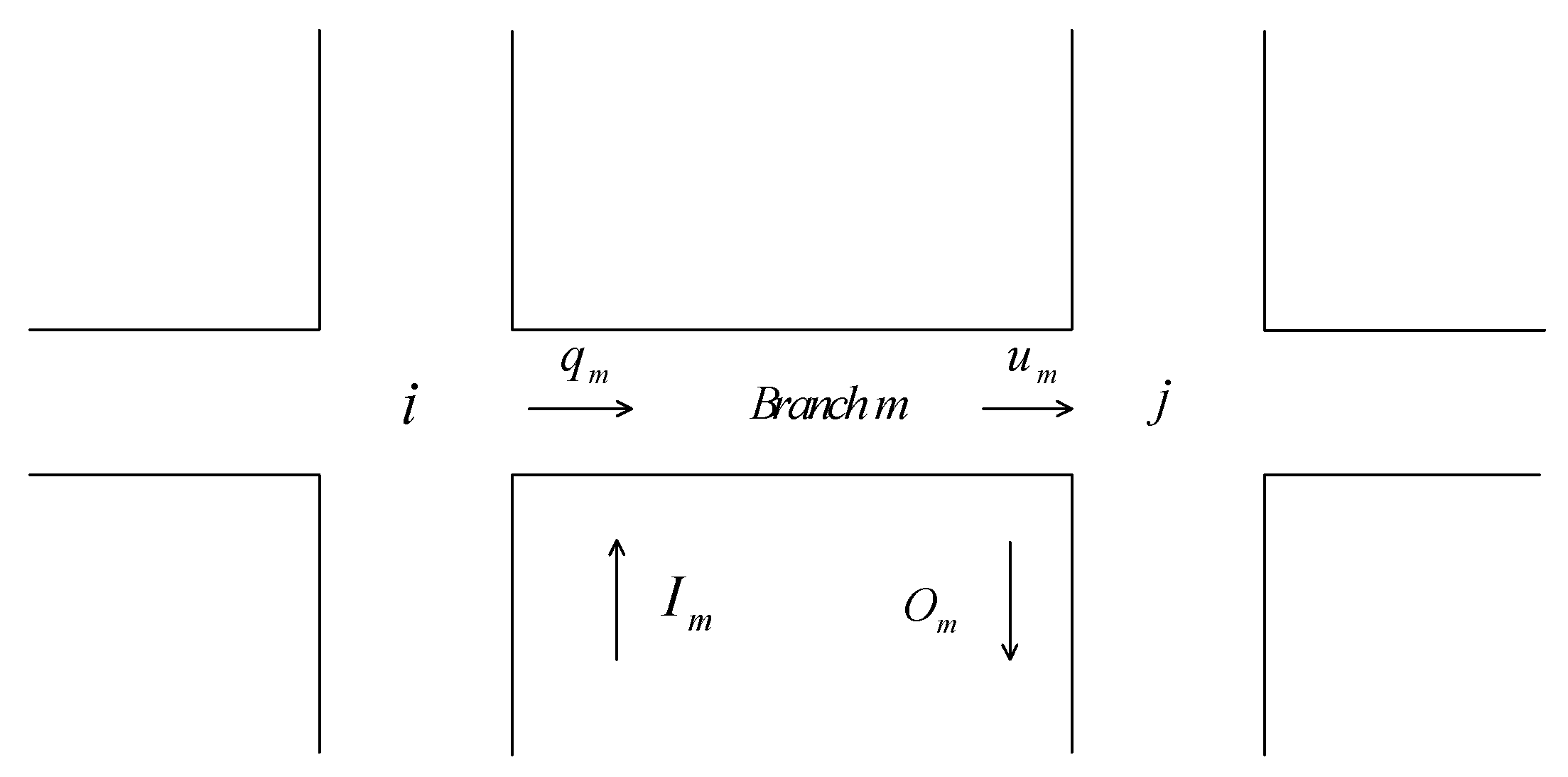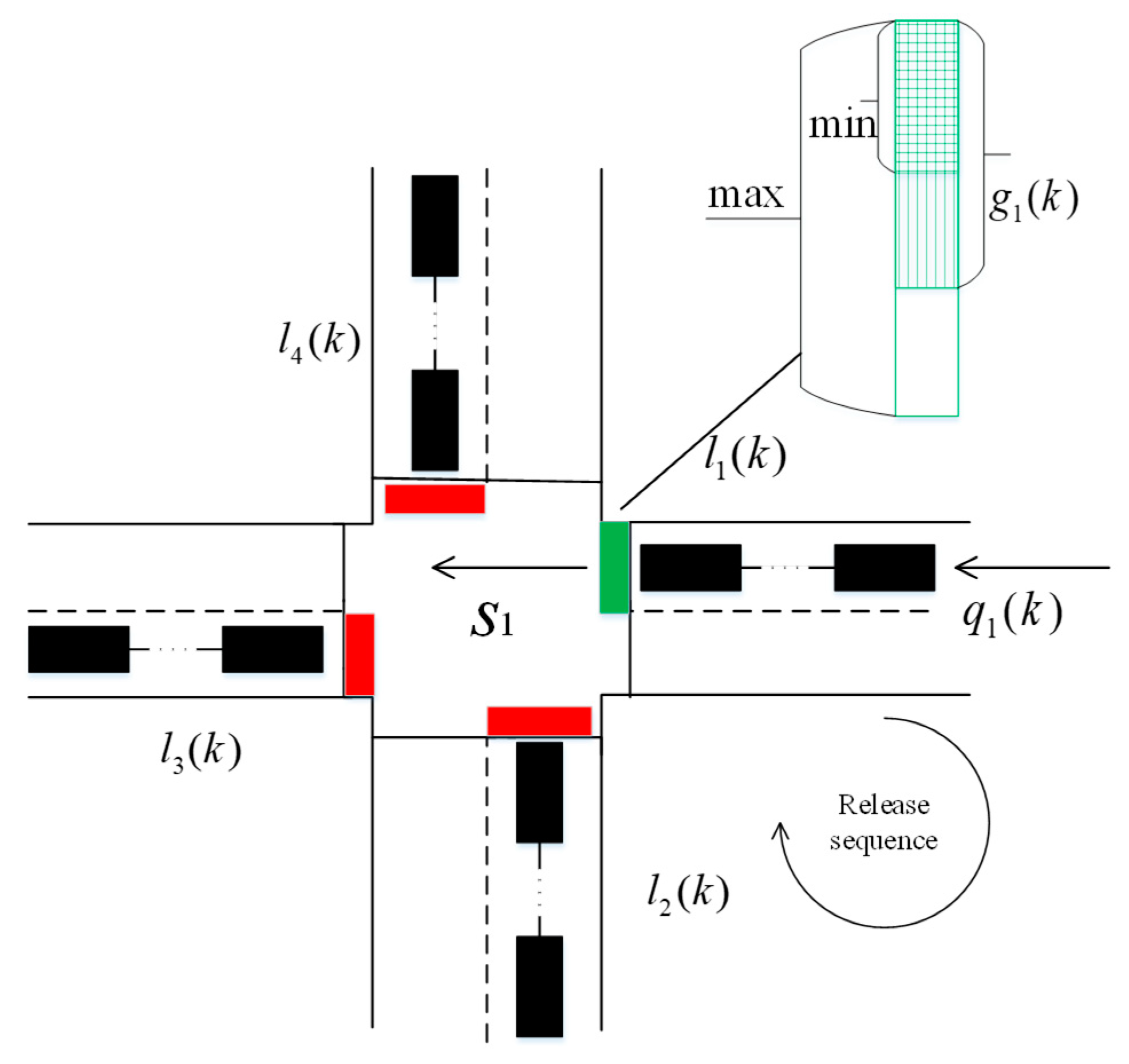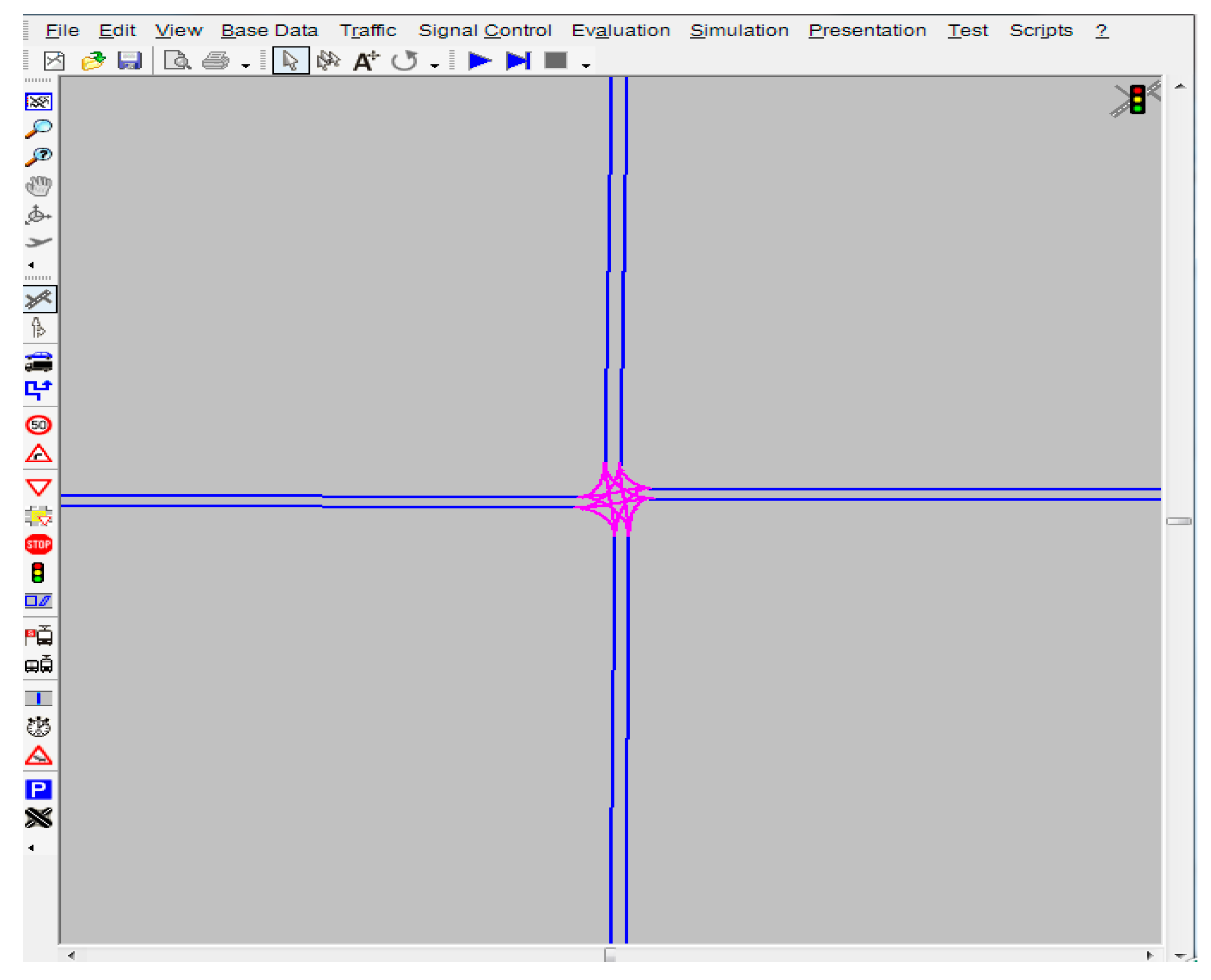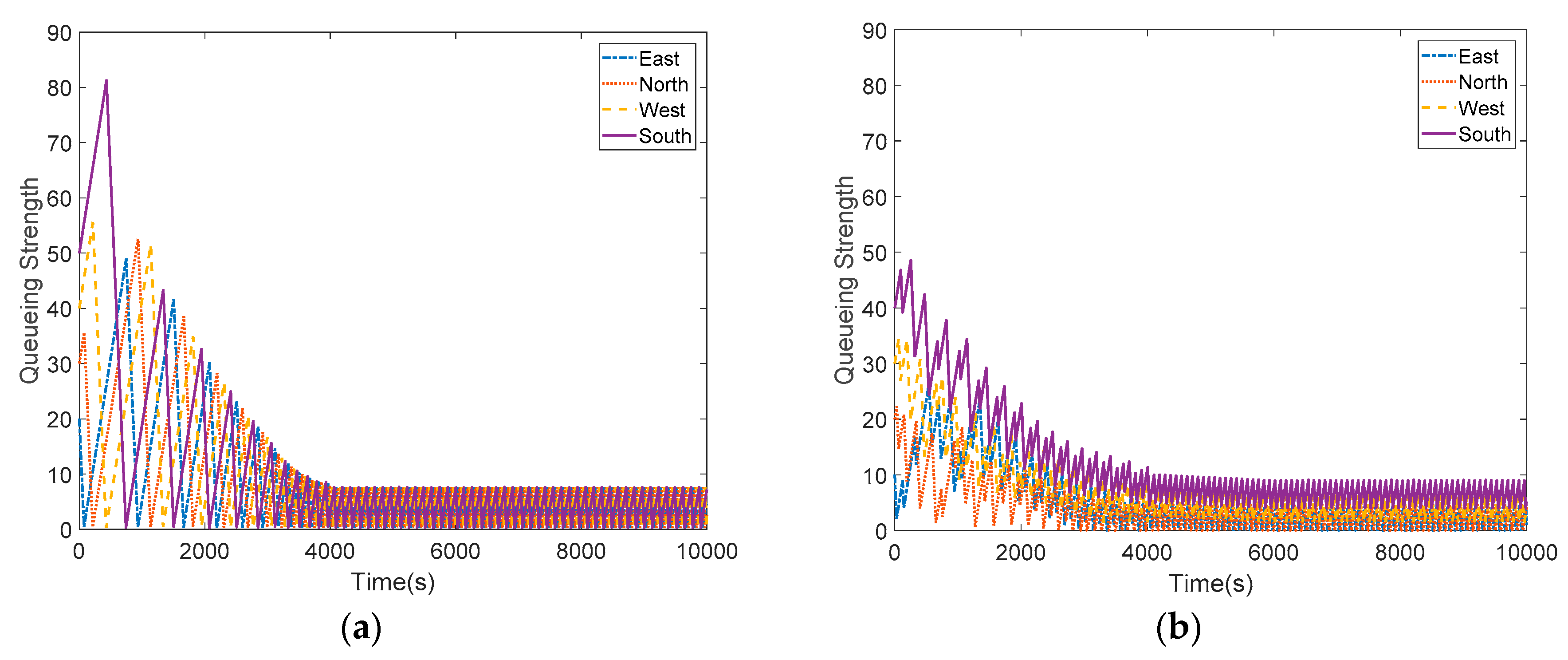Multi-Agent-Based Data-Driven Distributed Adaptive Cooperative Control in Urban Traffic Signal Timing
Abstract
1. Introduction
- (1)
- A rapid and recursive distributed adaptive corporative control strategy with online parameter learning law is proposed by using the queuing length and the network topology of multi-direction signal controllers at single intersection;
- (2)
- Traffic signal direction-sequence control is adopted here to avoid phase conflicts;
- (3)
- A flexible changeable cycle signal timing strategy is analyzed satisfying maximum and minimum green time constraints;
- (4)
- Both the undersaturation and supersaturation traffic flow conditions can be handled by the proposed MA-DD-DACC without distinction.
2. Preliminaries
2.1. Store-and-Forward Model
2.2. Multi-Directional Queuing Strength Model with Changeable Cycle
3. Problem Formulation and Controller Design
3.1. Cooperative Control Problem Describtion
3.2. Data-Driven Distributed Adaptive Cooperative Control Design
4. Stability Analysis
5. Simulation
6. Conclusions
Author Contributions
Funding
Conflicts of Interest
References
- Zhang, J.; Wang, F.Y.; Wang, K.; Lin, W.H.; Xu, X.; Chen, C. Data-Driven Intelligent Transportation Systems: A Survey. IEEE Trans. Intell. Transp. Syst. 2011, 12, 1624–1639. [Google Scholar] [CrossRef]
- Hou, Z.S.; Jin, S.T. Model Free Adaptive Control: Theory and Applications; CRC Press: Boca Raton, FL, USA, 2013. [Google Scholar]
- Xu, D.; Jiang, B.; Shi, P. A novel model-free adaptive control design for multivariable industrial processes. IEEE Trans. Ind. Electron. 2014, 61, 6391–6398. [Google Scholar] [CrossRef]
- Hou, Z.S.; Huang, W. The model-free learning adaptive control of a class of SISO nonlinear systems. In Proceedings of the 1997 American Control Conference, Albuquerque, NM, USA, 6 June 1997; Volume 1, pp. 343–344. [Google Scholar]
- Xu, J.X.; Tan, Y.; Lee, T.H. Iterative learning control design based on composite energy function with input saturation. Automatica 2004, 40, 1371–1377. [Google Scholar] [CrossRef]
- Hou, Z.S.; Liu, S.D.; Tian, T.T. Lazy-learning-based data-driven model-free adaptive predictive control for a class of discrete-time nonlinear systems. IEEE Trans. Neural Netw. Learn. Syst. 2017, 28, 1914–1928. [Google Scholar] [CrossRef] [PubMed]
- Sala, A. Integrating virtual reference feedback tuning into a unified closed-loop identification framework. Automatica 2007, 43, 178–183. [Google Scholar] [CrossRef]
- Hjalmarsson, H. From experiment design to closed-loop control. Automatica 2005, 41, 393–438. [Google Scholar] [CrossRef]
- Hou, Z.; Chi, R.; Gao, H. An overview of dynamic-linearization-based data-driven control and applications. IEEE Trans. Ind. Electron. 2017, 64, 4076–4090. [Google Scholar] [CrossRef]
- Markovsky, I. A missing data approach to data-driven filtering and control. IEEE Trans. Autom. Control 2017, 62, 1972–1978. [Google Scholar] [CrossRef]
- Webster, F.V. Traffic Signal Settings. Road Research Paper No. 39; Her Majesty’s Stationary Office: London, UK, 1958. [Google Scholar]
- Robertson, D.I.; Bretherton, R.D. Optimizing networks of traffic signals in real time—The scoot method. IEEE Trans. Veh. Technol. 1991, 40, 11–15. [Google Scholar] [CrossRef]
- Sims, A.G.; Dobinson, K.W. The Sydney Coordinated Adaptive Traffic (SCAT) system philosophy and benefits. IEEE Trans. Veh. Technol. 1980, 29, 130–137. [Google Scholar] [CrossRef]
- Keong, C.K. The GLIDE system—Singapore’s urban traffic control system. Transp. Rev. 1993, 13, 295–305. [Google Scholar] [CrossRef]
- Wang, F.; Zhang, H.; Liu, D. Adaptive dynamic programming: An introduction. IEEE Comput. Intell. Mag. 2009, 4, 39–47. [Google Scholar] [CrossRef]
- Ling, K.; Shalaby, A.S. A reinforcement learning approach to streetcar bunching control. J. Intell. Transp. Syst. Technol. Plan. Oper. 2005, 9, 59–68. [Google Scholar] [CrossRef]
- Abdulhai, B.; Pringle, R.; Karakoulas, G.J. Reinforcement learning for the true adaptive traffic signal control. J. Transp. Eng. 2003, 129, 278–285. [Google Scholar] [CrossRef]
- Salkham, A.; Cunningham, R.; Garg, A.; Cahill, V. A collaborative reinforcement learning approach to urban traffic control optimization. In Proceedings of the 2008 IEEE/WIC/ACM International Conference on Web Intelligence and Intelligent Agent Technology, Sydney, Australia, 9–12 December 2009; Volume 2, pp. 560–566. [Google Scholar]
- Hou, Z.S.; Xu, J.X.; Yan, J.W. An iterative learning approach for density control of freeway traffic flow via ramp metering. Transp. Res. C Emerg. Technol. 2008, 16, 71–97. [Google Scholar] [CrossRef]
- Hou, Z.S.; Xu, J.X.; Zhong, H.W. Freeway traffic control using iterative learning control based ramp metering and speed signaling. IEEE Trans. Veh. Technol. 2007, 56, 466–477. [Google Scholar] [CrossRef]
- Cheng, Z.; Hou, Z.; Jin, S. MFAC-based balance control for freeway and auxiliary road system with multi-intersections. In Proceedings of the 2015 10th Asian Control Conference (ASCC), Kota Kinabalu, Malaysia, 31 May–3 June 2015; pp. 1–6. [Google Scholar]
- Balaji, P.G.; Srinivasan, D. Multi-agent system in urban traffic signal control. IEEE Comput. Intell. Mag. 2010, 5, 43–51. [Google Scholar] [CrossRef]
- Choy, M.C.; Srinivasan, D.; Cheu, R.L. Neural networks for continuous online learning and control. IEEE Trans. Neural Netw. 2006, 17, 1511–1531. [Google Scholar] [CrossRef]
- Gokulan, B.P.; Srinivasan, D. Distributed multi-agent type-2 fuzzy architecture for urban traffic signal control. In Proceedings of the IEEE International Conference on Fuzzy Systems, Jeju Island, South Korea, 20–24 August 2009; pp. 1624–1632. [Google Scholar]
- Coupland, S.; John, R. New geometric inference techniques for type-2 fuzzy sets. Int. J. Approx. Reason. 2008, 49, 198–211. [Google Scholar] [CrossRef]
- He, Z.H.; Chen, Y.Z.; Shi, J.J.; Han, X.G.; Wu, X. Steady-state control for signalized intersections modeled as switched server system. In Proceedings of the 2013 American Control Conference, Washington, DC, USA, 17–19 June 2013; pp. 842–847. [Google Scholar]
- Choy, M.C.; Srinivasan, D.; Cheu, R.L. Cooperative, hybrid agent architecture for real-time traffic signal control. IEEE Trans. Syst. Man Cybern. A 2003, 33, 597–607. [Google Scholar] [CrossRef]
- Lin, W.; Qian, C.J. Adaptive control of nonlinearly parameterized systems: A nonsmooth feedback framework. IEEE Trans. Autom. Control 2002, 47, 757–774. [Google Scholar] [CrossRef]
- Sun, M.X.; Ge, S.S. Adaptive repetitive control for a class of nonlinearly parameterized systems. IEEE Trans. Autom. Control 2006, 51, 1684–1688. [Google Scholar] [CrossRef]
- Ji, H.H.; Lewis, F.L.; Hou, Z.S.; Mikulski, D. Distributed information-weighted Kalman consensus filter for sensor networks. Automatica 2017, 77, 18–30. [Google Scholar] [CrossRef]







| East | North | West | South | |
|---|---|---|---|---|
| Arrival flow (q/pcu*h−1) | 250 | 250 | 250 | 250 |
| Initial cycle (Co/s) | 128 | |||
| Initial queuing strength (Lm(0)/pcu) | 10 | 20 | 30 | 40 |
| Saturation flow rate (s/pcu*h−1) | 1200 | 1200 | 1200 | 1200 |
| Initial green time(g/s) | 10 | 10 | 10 | 10 |
| Lost time (tl/s) | 2 | 2 | 2 | 2 |
| The maximum queue value (lmax/pcu) | 100 | 200 | 300 | 400 |
| The maximum green time (gmax/s) | 70 | 70 | 70 | 70 |
| The minimum green time (gmin/s) | 10 | 10 | 10 | 10 |
| Quotiety (alpha) | 0.99 | 0.99 | 0.99 | 0.99 |
© 2019 by the authors. Licensee MDPI, Basel, Switzerland. This article is an open access article distributed under the terms and conditions of the Creative Commons Attribution (CC BY) license (http://creativecommons.org/licenses/by/4.0/).
Share and Cite
Zhang, H.; Liu, X.; Ji, H.; Hou, Z.; Fan, L. Multi-Agent-Based Data-Driven Distributed Adaptive Cooperative Control in Urban Traffic Signal Timing. Energies 2019, 12, 1402. https://doi.org/10.3390/en12071402
Zhang H, Liu X, Ji H, Hou Z, Fan L. Multi-Agent-Based Data-Driven Distributed Adaptive Cooperative Control in Urban Traffic Signal Timing. Energies. 2019; 12(7):1402. https://doi.org/10.3390/en12071402
Chicago/Turabian StyleZhang, Haibo, Xiaoming Liu, Honghai Ji, Zhongsheng Hou, and Lingling Fan. 2019. "Multi-Agent-Based Data-Driven Distributed Adaptive Cooperative Control in Urban Traffic Signal Timing" Energies 12, no. 7: 1402. https://doi.org/10.3390/en12071402
APA StyleZhang, H., Liu, X., Ji, H., Hou, Z., & Fan, L. (2019). Multi-Agent-Based Data-Driven Distributed Adaptive Cooperative Control in Urban Traffic Signal Timing. Energies, 12(7), 1402. https://doi.org/10.3390/en12071402





